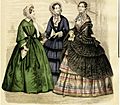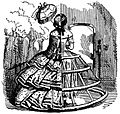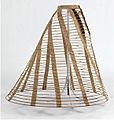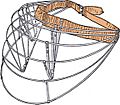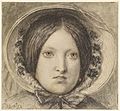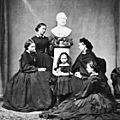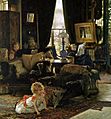Victorian fashion facts for kids
Victorian fashion describes the clothing styles and trends popular in the United Kingdom and the British Empire. This period, known as the Victorian era, lasted from the 1830s to the early 1900s. During these years, fashion changed a lot, affecting not just clothes but also art and literature.
In the early Victorian years, women's dresses were simple and often light-colored. Being modest was very important. This meant dresses usually covered the arms and went all the way down to the ankles.
By 1907, many clothes were made in factories. You could buy them in big department stores that had set prices. People still sewed clothes at home or had them custom-made, but this was becoming less common. New machines and materials changed how clothes were made.
Victorian Fashion: A Look Back
How Clothes Were Made
The sewing machine was invented in the middle of the Victorian era. This machine made it much easier to sew clothes at home. It also made it simple to add fancy decorations that would have been very expensive to do by hand.
Machines also made lace for a lot less money than old hand-made lace. Inventors also created new, bright dyes, like mauveine. These new dyes were much cheaper than the older dyes made from plants or animals.
Images for kids
-
1844 fashion plate showing fashionable clothing for men and women, including a glove and bonnets
-
A Victorian dandy pictured in the 1840s
-
Emma Hill by Ford Madox Brown (1853), a woman wearing a later version of the poke bonnet
-
Victorian interior: Hide and Seek by James Tissot, c. 1877
-
Dress designed by Charles Frederick Worth for Elisabeth of Austria painted by Franz Xaver Winterhalter.
-
William Powell Frith's painting of 1883 contrasts women's Aesthetic dress (left and right) with fashionable attire (center).
-
Day dress, c. 1875 James Tissot painting.
-
Whistler's Portrait of Lady Meux, 1882
-
Renoir's portrait of Jeanne Samary in an evening gown, 1878
-
Portrait by Alexander Melville of Queen Victoria, 1845
-
An artistic interior: Dante Gabriel Rossetti reading to Theodore Watts-Dunton in the drawing room at No. 16 Cheyne Walk, 1882
-
Men's swimwear: Cartoon from Punch by George du Maurier








